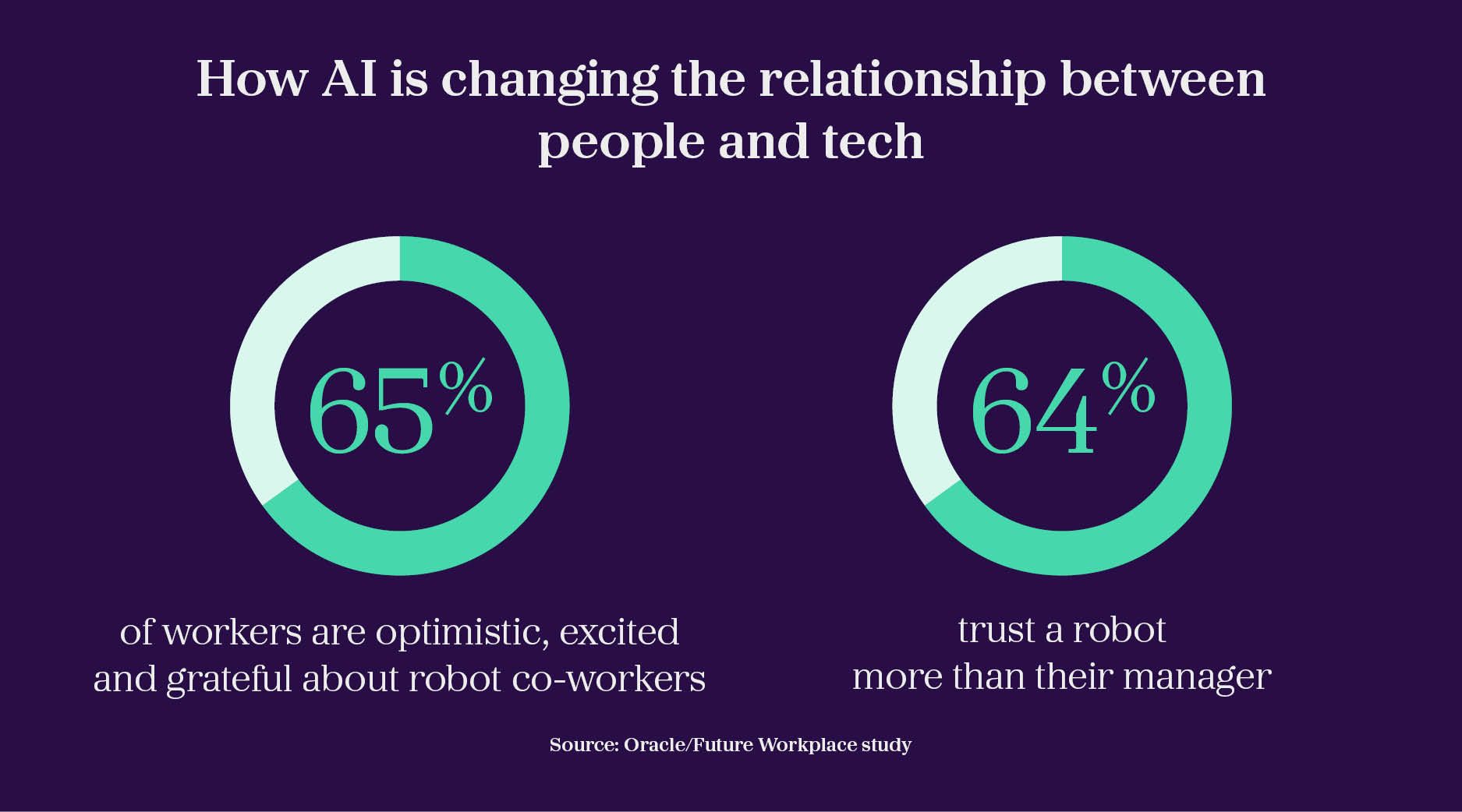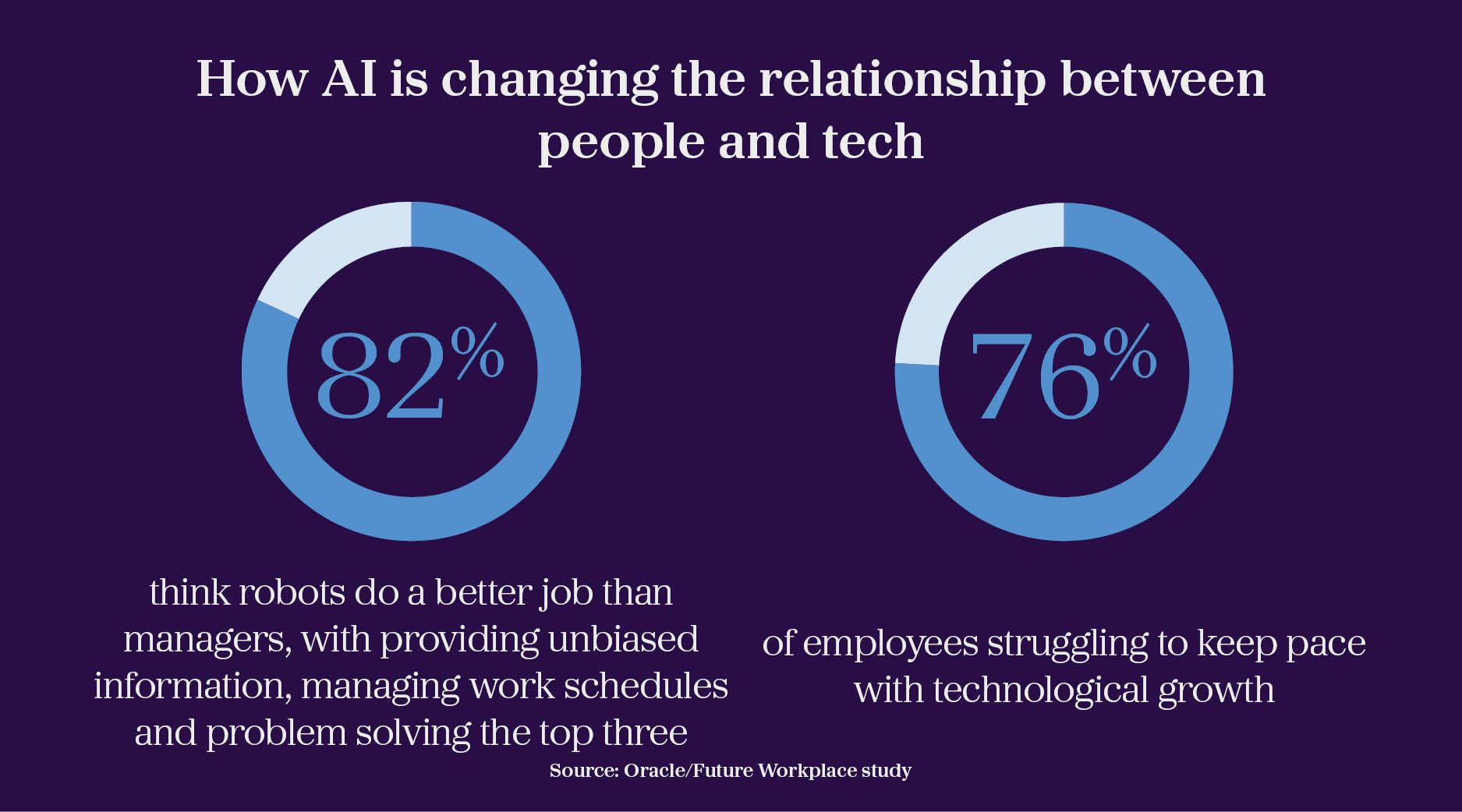Myth number 5:
Operationalizing AI technology in my business will be straightforward

When it comes to talent technology, artificial intelligence solutions have been gaining the most traction over the previous three years. During the pandemic, a gulf opened up between organizations who’d invested in technology and those who had not. Those who had successfully operationalized tech pre-2020 found it easier to pivot operations from office to home environments and many companies made it a priority to ensure they would not be caught out in future.
Before the height of pandemic lockdowns, AI adoption was most prevalent in the front office, with the primary focus being in business functions such as risk and compliance, or measuring consumer behaviours. Only 10% of companies reported adoption of AI in their talent function, according to McKinsey’s The State of AI in 2020 reporting.
A 2019 study by Oracle and Future Workplace suggested that half of all employees were using some form of artificial intelligence at work, with 65% ‘optimistic, excited and grateful’ about having robot co-workers. Furthermore, artificial intelligence was changing how employees interacted with their managers. According to the report, 64% of employees trusted a robot more than their manager and more than four in five (82%) believed artificial intelligence could do things better than their managers.

With the impact of AI still in its infancy, the key challenge for businesses - according to employees - was to simplify its use, with 34% asking for a better user interface, 30% asking for best practice training and 30% wanting a personalized experience.
“Our results reveal that forward looking companies are already capitalizing on the power of AI. As workers and managers leverage the power of AI in the workplace, they are moving from fear to enthusiasm as they see the possibility of being freed of many of their routine tasks and having more time to solve critical business problems for the enterprise,” said Future Workplace founding director Jeanne Meister.
Though the early stages of this period saw most organizations investing with extreme caution, the continued evolution of AI tech for talent management more than accelerated with substantial funding for AI tech firms specializing in talent solutions being announced in the hundreds of millions.

Fast-forward post-pandemic - where artificial intelligence techniques like machine learning and natural language processing provided vital information and predictions about the spread of the virus - and more and more companies are operationalizing artificial intelligence to drive strategic business value.
This is especially true in HR with the unprecedented speed of economic recovery causing significant skills and talent shortages globally, making data, insight and talent management strategies and solutions mission critical for many CEOs.
Indeed, by the end of 2024, 75% of organizations will shift from piloting artificial intelligence projects to operationalizing them, according to a report by Gartner, making it their number one trend in data and analytics technology.
Scaling challenges
In the talent and recruitment sector, artificial intelligence providers have done extensive development and research to ensure that their interfaces are modern and intuitive, making them easier to use for clients. They can also offer a wealth of additional insights to end users to aid evaluation and decision making in recruitment, with the potential to replace more static systems like applicant tracking systems.
However, moving from piloting an individual artificial intelligence program to scaling it across an entire department or product is challenging, with many struggling to reach the full operational potential of artificial intelligence technology.
As Manasi Vartak, CEO and founder of AI scaling platform Verta writes in Harvard Business Review: “AI is most valuable when it is operationalized at scale. For business leaders who wish to maximize business value using AI, scale refers to how deeply and widely AI is integrated into an organization’s core product, service and business process.
“Unfortunately, scaling AI in this sense isn’t easy. Getting one or two AI models into production is very different from running an entire enterprise or product on AI. And as AI is scaled, problems can scale too.”
So what are the issues to avoid?
The first challenge is around gaining buy-in from employers whose job roles will be impacted within a new operating model. In talent acquisition for example, different considerations need to be worked through depending on whether you have a segmented model, or a team of 360 recruiters.
However, adoption of AI is only going to continue to grow. More than a third of companies already use AI and 42% are exploring AI implementation in 2023, according to data from IBM. Businesses need to acknowledge that recruitment job roles - and a strong adoption strategy requires organizations to prepare their people for the skills they’ll need to leverage AI effectively.
This means providing ongoing training and enablement on new AI technology that moves beyond the purely functional. A stronger focus on data analysis and working with enhanced data sets is a must.
In turn, this should free up talent acquisition professionals to focus on what they do best, which is to form strong, trusted partnerships with the business, have conversations with candidates and make personal connections.

When it comes to talent technology, artificial intelligence solutions have been gaining the most traction over the previous three years. During the pandemic, a gulf opened up between organizations who’d invested in technology and those who had not. Those who had successfully operationalized tech pre-2020 found it easier to pivot operations from office to home environments and many companies made it a priority to ensure they would not be caught out in future.
Before the height of pandemic lockdowns, AI adoption was most prevalent in the front office, with the primary focus being in business functions such as risk and compliance, or measuring consumer behaviours. Only 10% of companies reported adoption of AI in their talent function, according to McKinsey’s The State of AI in 2020 reporting.
A 2019 study by Oracle and Future Workplace suggested that half of all employees were using some form of artificial intelligence at work, with 65% ‘optimistic, excited and grateful’ about having robot co-workers. Furthermore, artificial intelligence was changing how employees interacted with their managers. According to the report, 64% of employees trusted a robot more than their manager and more than four in five (82%) believed artificial intelligence could do things better than their managers.

With the impact of AI still in its infancy, the key challenge for businesses - according to employees - was to simplify its use, with 34% asking for a better user interface, 30% asking for best practice training and 30% wanting a personalized experience.
“Our results reveal that forward looking companies are already capitalizing on the power of AI. As workers and managers leverage the power of AI in the workplace, they are moving from fear to enthusiasm as they see the possibility of being freed of many of their routine tasks and having more time to solve critical business problems for the enterprise,” said Future Workplace founding director Jeanne Meister.
Though the early stages of this period saw most organizations investing with extreme caution, the continued evolution of AI tech for talent management more than accelerated with substantial funding for AI tech firms specializing in talent solutions being announced in the hundreds of millions.

Fast-forward post-pandemic - where artificial intelligence techniques like machine learning and natural language processing provided vital information and predictions about the spread of the virus - and more and more companies are operationalizing artificial intelligence to drive strategic business value.
This is especially true in HR with the unprecedented speed of economic recovery causing significant skills and talent shortages globally, making data, insight and talent management strategies and solutions mission critical for many CEOs.
Indeed, by the end of 2024, 75% of organizations will shift from piloting artificial intelligence projects to operationalizing them, according to a report by Gartner, making it their number one trend in data and analytics technology.
Scaling challenges
In the talent and recruitment sector, artificial intelligence providers have done extensive development and research to ensure that their interfaces are modern and intuitive, making them easier to use for clients. They can also offer a wealth of additional insights to end users to aid evaluation and decision making in recruitment, with the potential to replace more static systems like applicant tracking systems.
However, moving from piloting an individual artificial intelligence program to scaling it across an entire department or product is challenging, with many struggling to reach the full operational potential of artificial intelligence technology.
As Manasi Vartak, CEO and founder of AI scaling platform Verta writes in Harvard Business Review: “AI is most valuable when it is operationalized at scale. For business leaders who wish to maximize business value using AI, scale refers to how deeply and widely AI is integrated into an organization’s core product, service and business process.
“Unfortunately, scaling AI in this sense isn’t easy. Getting one or two AI models into production is very different from running an entire enterprise or product on AI. And as AI is scaled, problems can scale too.”
So what are the issues to avoid?
The first challenge is around gaining buy-in from employers whose job roles will be impacted within a new operating model. In talent acquisition for example, different considerations need to be worked through depending on whether you have a segmented model, or a team of 360 recruiters.
However, adoption of AI is only going to continue to grow. More than a third of companies already use AI and 42% are exploring AI implementation in 2023, according to data from IBM. Businesses need to acknowledge that recruitment job roles - and a strong adoption strategy requires organizations to prepare their people for the skills they’ll need to leverage AI effectively.
This means providing ongoing training and enablement on new AI technology that moves beyond the purely functional. A stronger focus on data analysis and working with enhanced data sets is a must.
In turn, this should free up talent acquisition professionals to focus on what they do best, which is to form strong, trusted partnerships with the business, have conversations with candidates and make personal connections.

Expert commentary
Erica Titchener
Global Head of Technology and Analytics, AMS

Gaining ROI for your AI investment
Technology in HR recruiting has been around for a while, but the level of insight you get when you introduce artificial intelligence that include additional data points recruiters aren’t accustomed to can be daunting.
This means that in order to successfully integrate AI technology and get a return on investment, businesses need to engage all relevant stakeholders who might be impacted by the tool and work out exactly what outcome they want. It might be efficiency, it might be workforce visibility, it might be getting to candidates quicker. Work out what you actually want to solve before purchasing.
Some vendors don’t appreciate that in large organizations, you need to make decisions at certain stages of a process that require data points that don’t feed into AI systems, such as those around compliance, or proof of accreditation. Secondly, focus on integration with your core HR platform.
While many vendors say you can use AI interfaces for intelligence alongside another system of record, the truth is talent professionals need as much data as possible in one place to make decisions.
As soon as you miss one of these key data points and a user has to go elsewhere, you start to lose adoption.
Another consideration when operationalizing artificial intelligence is the need to understand the change management program that goes alongside it. When working with clients who have implemented technology but are struggling with return on investment, more than 50% of the time the organization didn't fully understand the impact of the technology they were implementing nor accurately articulated the benefits proposition of doing so.
In some cases, they massively oversold what the technology could do without providing programmatic help in the background, or in others they tried to creep it into the organization under the radar, because they were scared of change management. In both cases, adoption will ultimately fail.
It’s important to remember that bringing in efficiencies with artificial intelligence changes people’s roles. If you have a team that has been very manual in the past, it will inevitably have headcount implications. Someone who spent 50% of their time doing an administrative task might now only spend 15%, with the rest being value add to the business. This requires a different skillset and might even be a different person. New skills are required.
Finally, many organizations make the mistake of deploying technology but not putting any structure or accountability into place for adoption. IT implements the technology and works on changes without fully understanding what the business is trying to achieve. What is needed is a business partner or analyst whose primary role is to get return on investment from the platform. You might be paying a lot for the software, but if you don’t have this person in place, you will struggle to gain full value from your investment.

Expert commentary
Florenta Teodoridis
Associate Professor Strategy, Marshall School of Business, University of Southern California
The future of artificial intelligence
When we talk about the impact of AI on the future of work, often we take the view that AI is set and we’re just waiting for the impact to unfold. This isn’t the case.
Artificial intelligence is a developing technology and the choices we make will affect how it impacts the future of work. We could choose to take a direction that focuses on the automation of existing tasks, which will push more displacement of people from jobs, or we could focus on building technology that complements the work individuals do.
An example is the potential benefits of AI in healthcare and education, where you can offer customized treatment to patients or education opportunities for individuals. If you think about education in particular, we haven’t reformed how we teach people in some time. One instructor teaches a class, but each individual learns differently. AI will always ask us to customize how we teach people - it will offer complementary teaching to individuals, rather than displacing existing teachers.
When thinking about how AI affects recruitment, it’s important to remember that AI is a goal, not a technology. Put simply, the aim of AI is to automate every task a human being can do. As technology advances, the more tasks AI is able to perform. However, there are always points at which we cannot push any further, as humans are predictable in some ways, but not others.
It’s also important to remember that we are looking for an algorithm to give us a perfect answer, or the perfect hire. However, as humans, we never have the perfect answer. Everything we do has a bias included, whether explicit or implicit. It’s a very high bar to expect artificial intelligence to solve everything for us, when the algorithms are simply mimicking our own human behavior - and we haven’t solved our own biases yet.
With so many different tools providing
information on different areas, it can be easy for users to become overwhelmed by data

A second challenge around AI implementation is the quality of integration with existing systems in the talent acquisition process. While AI tools can streamline hiring processes, reduce bias in selection and identify best fit candidates, they still need to be integrated into a business’ existing ecosystem to ensure that all critical external and internal data points are available to decision makers throughout the recruitment process.
However, with so many different tools providing information on different areas, it can be easy for users to become overwhelmed by data or frustrated at having to go off system to obtain missing information. This can lead them to stop using AI tools and return to old ways of recruiting, diminishing ROI.
To avoid this, organizations are taking a two-fold approach. The first step is in the procurement stage, where it’s imperative to ensure you understand the reason behind and expected outcome from utilizing talent technology. The fewer tools your recruitment team needs to learn, the better the chance of integration succeeding and the more valuable the output.
Secondly, many organizations have enormous ‘technical debt’ - existing legacy technological systems that are unwieldy, out of date and unable to support integration. Transforming these systems and building in new functionality is a huge challenge, requiring organizations to change the skillset of their technology and IT teams too. As technology requirements grow, so does the need for those with the skills available to lead these changes.
Finally - and building on the previous point about the need for new skills in IT to manage transition - many organizations fail to build roles into their operating models and business cases that focus on the overall success and evolution of the technology they use. In order to maximize the relationship with an artificial intelligence technology partner, organizations need to be aware of the full capabilities of the technology and how its use can evolve as integration grows.
“Technology will continue to develop, impact and transform the world of work and recruitment processes.”
A strategic adoption plan may start with the use of one element of a technology, but should then take a long-term approach to maximizing its capabilities with ongoing integration. This requires a team who understand an organization’s strategic business aims and can match this to technological key performance indicators.
After all, one thing businesses can be sure about is that technology will continue to develop, impact and transform the world of work and recruitment processes. Ensuring you have a team who can keep on top of advances in artificial intelligence and build use cases into your strategic goals is vital to future success.


